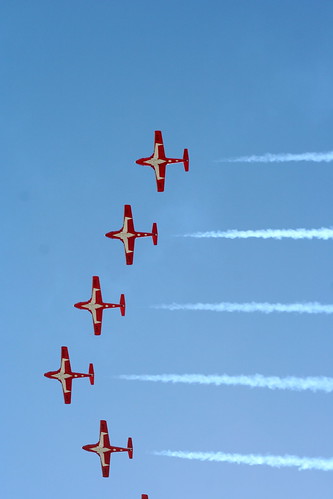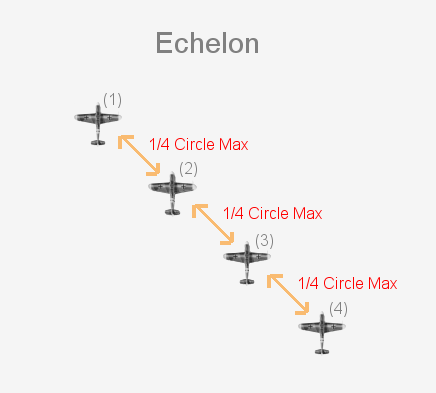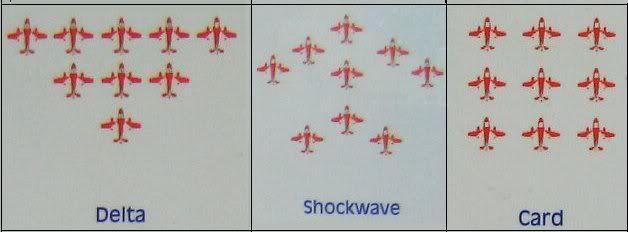Post by HG on May 12, 2010 7:08:27 GMT -5
(Note these are based off of flying aircrafts but the same basic principles would apply to Dragons)
Formation Flying:
The Trail Formation

The trail formation consists of the dragons lined up behind each other with approximately 250 yards of separation between them. This formation is used primarily for ground attack. It is a near useless formation for air-to-air works due to the positioning not allowing for much in the way of mutual support
The Finger Four Formation

This formation offers the best flexibility and capability to cover each other. Enroute this can be flown as a tight formation, however once approaching the combat zone, the formation should "kick out" into a more spread out form. Approximately 300-400 yards between dragons is appropriate, as this allows for mutual support during Threadfall.
The Four Finger Formation consists of four separate groups designated as a "Flight". Each flight is made up of two parts. When looking down on the formation from above, the positions of the planes resembles that of the tips of the four digits of a human , hence its name.
The Lead Element is made up of the flight leader at the very front of the formation and one wingman to his rear left. The Second Element is made up of an additional two dragons, the element leader and his wingman. The element leader is to the right and rear of the flight leader and his wingman is also to the right and rear of himself.
Four of these Flights can be assembled to form a Squadron Formation which consists of two staggered lines of fighters, one in front of the other. Each flight is usually designated by a color (i.e. Red, Blue, Yellow, and Green).
Echelon Formation

This formation would be used primarily to guard against a probable threat to either the left or right (echelon left or echelon right) It offers a great field fo view for the participants, and allows a quick heading change for all to a line abreast formation to counter a threat recieved from the direction of the formation.
An echelon formation is a military formation in which members are arranged diagonally. Each member is stationed behind and to the right (a 'right echelon'), or behind and to the left ('left echelon'), of the member ahead. The name of the formation comes from the French word échelle, meaning ladder, which describes the staircase effect that this formation has when viewed from above.
The Wedge Formation:

This basic wedge formation allows for great maneuverability and speed. No dragon is closer than one wingspan to any other, and all have the wing leader in their field of vision.
The Sail formation:

The sail formation is essentially a modified wedge. Less maneuverable and more difficult to maintain, it nevertheless allows one fleet to cover a broader area and is thus well-suited for flying Thread.
Search formation:

The Search formation allows one Wing to break up into smaller groups and search or explore a wide area. It is not designed for fighting, but instead for maneuverability and for maximizing visibility. In addition to searching, it is suited for rescue missions and routine patrols.
Small scale formations:

These are used in smaller groups but can be modified for Wings.
(To be continued...)
Formation Flying:
The Trail Formation

The trail formation consists of the dragons lined up behind each other with approximately 250 yards of separation between them. This formation is used primarily for ground attack. It is a near useless formation for air-to-air works due to the positioning not allowing for much in the way of mutual support
The Finger Four Formation

This formation offers the best flexibility and capability to cover each other. Enroute this can be flown as a tight formation, however once approaching the combat zone, the formation should "kick out" into a more spread out form. Approximately 300-400 yards between dragons is appropriate, as this allows for mutual support during Threadfall.
The Four Finger Formation consists of four separate groups designated as a "Flight". Each flight is made up of two parts. When looking down on the formation from above, the positions of the planes resembles that of the tips of the four digits of a human , hence its name.
The Lead Element is made up of the flight leader at the very front of the formation and one wingman to his rear left. The Second Element is made up of an additional two dragons, the element leader and his wingman. The element leader is to the right and rear of the flight leader and his wingman is also to the right and rear of himself.
Four of these Flights can be assembled to form a Squadron Formation which consists of two staggered lines of fighters, one in front of the other. Each flight is usually designated by a color (i.e. Red, Blue, Yellow, and Green).
Echelon Formation

This formation would be used primarily to guard against a probable threat to either the left or right (echelon left or echelon right) It offers a great field fo view for the participants, and allows a quick heading change for all to a line abreast formation to counter a threat recieved from the direction of the formation.
An echelon formation is a military formation in which members are arranged diagonally. Each member is stationed behind and to the right (a 'right echelon'), or behind and to the left ('left echelon'), of the member ahead. The name of the formation comes from the French word échelle, meaning ladder, which describes the staircase effect that this formation has when viewed from above.
The Wedge Formation:

This basic wedge formation allows for great maneuverability and speed. No dragon is closer than one wingspan to any other, and all have the wing leader in their field of vision.
The Sail formation:

The sail formation is essentially a modified wedge. Less maneuverable and more difficult to maintain, it nevertheless allows one fleet to cover a broader area and is thus well-suited for flying Thread.
Search formation:

The Search formation allows one Wing to break up into smaller groups and search or explore a wide area. It is not designed for fighting, but instead for maneuverability and for maximizing visibility. In addition to searching, it is suited for rescue missions and routine patrols.
Small scale formations:

These are used in smaller groups but can be modified for Wings.
(To be continued...)

